|
Weathering the Test of Time
by
Bob Brooke
For the last 150 or so
years, weather vanes have become a symbol of America. In the 18th and
19th centuries the weather governed the lives of both seafarers and
farmers, thus making the weathervane more practical than ornamental.
These ubiquitous objects topped many a building in the 19th century. And
while there aren’t as many today, they can still be seen here and there,
especially in the rural landscape.

Weathervanes in Early Times
The first documented weather vane honored Greek demigod Triton, the
half-man, half-fish son of Poseidon. Triton's role in mythology was to
still the ocean's waves, and his bronze likeness topped the Tower of the
Winds, built around 48 B.C.E in Athens. The ancient Greeks believed wind
had divine power, so they naturally fashioned their weather vanes after
Greek gods.
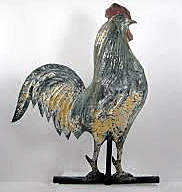 Archaeological
studies reveal that Viking explorers had quadrant-shaped vanes attached
to their ships. Later in the century, a papal decree ordered the symbol
of a rooster be placed on all church rooftops. The rooster represented
Peter's denial of Christ, and acted as a reminder for the faithful to
attend services. Archaeological
studies reveal that Viking explorers had quadrant-shaped vanes attached
to their ships. Later in the century, a papal decree ordered the symbol
of a rooster be placed on all church rooftops. The rooster represented
Peter's denial of Christ, and acted as a reminder for the faithful to
attend services.
By the 17th century, weather vanes had become a common addition to the
roofs of European and English buildings. Makers also imported them to
America for mounting on civic buildings and churches. As the 18th
century progressed, weather vanes became an integral part of American
history and architecture.
Weathervanes in America
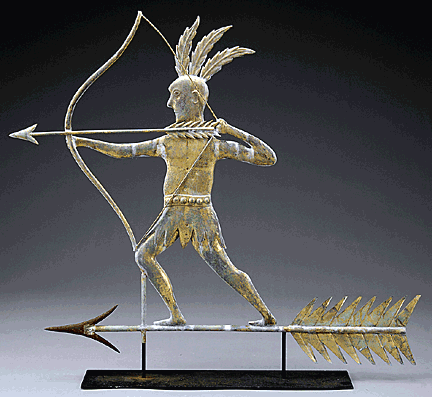 Deacon
Shem Drowne produced the earliest authenticated American weather vane, a
large copper Indian, made in 1716 for Province House, Boston. A prolific
designer and maker of weather vanes, he’s best known for his glass-eyed
copper grasshopper, which has sat atop Boston's Faneuil Hall since 1749. Deacon
Shem Drowne produced the earliest authenticated American weather vane, a
large copper Indian, made in 1716 for Province House, Boston. A prolific
designer and maker of weather vanes, he’s best known for his glass-eyed
copper grasshopper, which has sat atop Boston's Faneuil Hall since 1749.
To symbolize the end of the Revolutionary War in 1787, George Washington
commissioned Joseph Rakestraw of Philadelphia to make a “Dove of Peace”
weather vane for his estate at Mount Vernon.
At the same time, amateur woodworkers and blacksmiths frequently made
early American weathervanes using various available metals, including
iron or sheet tin. The most common designs featured an endless variety
of barnyard animals and horses, as well as Christian symbols, such as
the angel Gabriel with a trumpet or a fish.
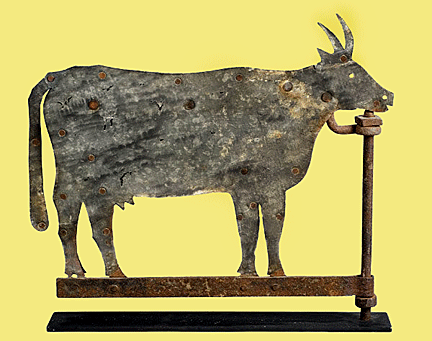 Alvin
Jewell of Massachusetts first introduced mass-produced weather vanes to
America in 1852. A skilled designer and pattern maker, Jewell poured
copper into iron molds based on carved wooden templates. He then
soldered the two identical copper halves together and covered them with
gold leaf. In his catalog, eagles and roosters were the most commonly
featured designs. Alvin
Jewell of Massachusetts first introduced mass-produced weather vanes to
America in 1852. A skilled designer and pattern maker, Jewell poured
copper into iron molds based on carved wooden templates. He then
soldered the two identical copper halves together and covered them with
gold leaf. In his catalog, eagles and roosters were the most commonly
featured designs.
Unfortunately, Jewell's luck changed in 1867, when his scaffolding
collapsed while he was erecting a sign. After his death, Josephus Harris
purchased his goods, tools, patterns and molds for the princely sum of
$7,950. But Harris failed to post the required security, so Jewell's
thriving business became the property of Leonard Cushing & Stillman
White. Harris finally obtained the funds to start his own weather vane
business the following year, and Harris & Company became a direct
competitor of Cushing & White. In 1872, Cushing bought out his partner,
taking his two sons into the family business. L.W. Cushing & Sons was
one of the few makers whose weather vane business survived into the 20th
century. One of their most famous is the “Columbia,” patented in 1868.
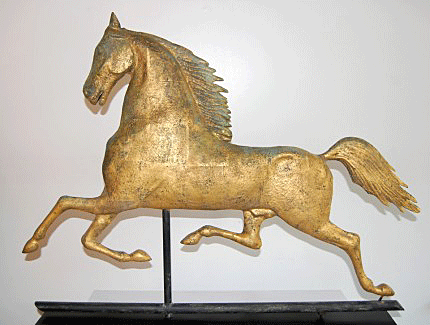 The
last major American company formed in the 19th century was the
Westervelt Company, which began in 1883 and ceased operations by 1890.
Another noted 19th century American manufacturer was J.W. Fiske of New
York City who produced a three-dimensional trotting stallion, the
champion trotter Black Hawk, in 1875. The
last major American company formed in the 19th century was the
Westervelt Company, which began in 1883 and ceased operations by 1890.
Another noted 19th century American manufacturer was J.W. Fiske of New
York City who produced a three-dimensional trotting stallion, the
champion trotter Black Hawk, in 1875.
Examples attributed to any of these early makers command top dollar in
today's market. An all-time record of $770,000 was set for a horse and
rider weather vane, attributed to J. Howard in January 1990—a record
that still stands today.
The Golden Age of Weathervanes
The golden age of weather vanes lasted from 1875 to 1895. As weather
vanes increased in popularity, makers geared their designs towards all
sorts of commercial interests, from farm animals to fire engines to
locomotives. They also offered patriotic symbols as well as images of
race horses of the day.
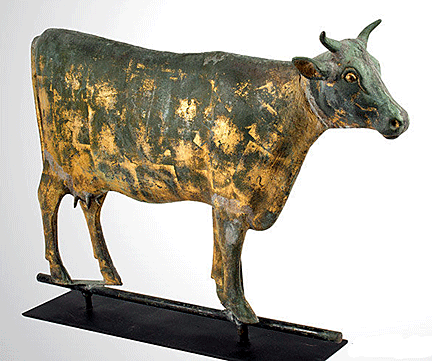 The
weather vane also found its way to the rooftops of Midwestern barns. In
the 19th century, most farmers valued their barns more than their
houses. From about 1880 to 1917, traveling lightning rod salesmen
offered weather vanes with decorative options such as colorful glass
balls and wind directionals in the shapes of horses, cows, roosters and
pigs. Sheep are rare while horses are the most common. The
weather vane also found its way to the rooftops of Midwestern barns. In
the 19th century, most farmers valued their barns more than their
houses. From about 1880 to 1917, traveling lightning rod salesmen
offered weather vanes with decorative options such as colorful glass
balls and wind directionals in the shapes of horses, cows, roosters and
pigs. Sheep are rare while horses are the most common.
These lightning rod weather vanes weren’t nearly as large or ornate as
those in New England ones. Generally made of tin or zinc, although there
are some made of copper and brass, they were just part of the barn. Most
examples still go for less than $1,000, although a rare one, such as an
eagle, might reach the $2,000 to $3,000 range. A small trotting horse
might still sell for $150 to $250.
Most lightning rod weather vanes clearly show the ravages of time. Many
have bullet holes, created during target practice. The materials used,
especially zinc and tin, have rusted and corroded over the years. These
units were simply part of a barn's roof for 75 to 100 years. In fact,
most only came down when the barn did.
As the 20th century dawned, a new era of silhouette style vanes, many
created entirely by hand, began. Artisans used heavy gauge brass, iron,
cast aluminum, and sheet steel for their creations. While still
collectible, early 20th century weather vanes often command a fraction
of their earlier counterparts. Copper body, zinc head and gilded
examples always sell for a higher price than a silhouette fashioned from
another metal.
Determining Value
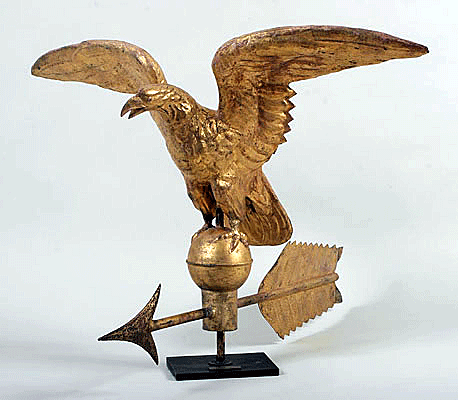 There
are some exceptions. When it comes to weather vanes, older isn't
necessarily better. The value of a weather vane depends on four
things—age, condition, patina and rarity. Weather vanes produced prior
to 1900 were made from molds with detail. Around 1920, the production of
weather vanes shifted from handwork to machine work, and manufacturers
paid less attention to the molds themselves. To determine age,
collectors first look for definition, such as the feathers on a rooster
or the head or tail on a horse. Lumpy, formless shapes are indicative of
later weather vanes. They’re of less value largely because they aren't
as attractive as one with great detail. There
are some exceptions. When it comes to weather vanes, older isn't
necessarily better. The value of a weather vane depends on four
things—age, condition, patina and rarity. Weather vanes produced prior
to 1900 were made from molds with detail. Around 1920, the production of
weather vanes shifted from handwork to machine work, and manufacturers
paid less attention to the molds themselves. To determine age,
collectors first look for definition, such as the feathers on a rooster
or the head or tail on a horse. Lumpy, formless shapes are indicative of
later weather vanes. They’re of less value largely because they aren't
as attractive as one with great detail.
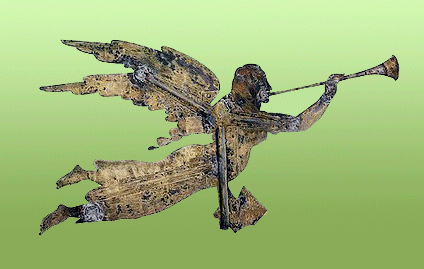 But
the most important thing to consider when determining the value of an
antique weather vane is patina. The current marketplace values original
gold leaf, but this is rare. Original gold leaf that has been exposed to
the elements for many years will eventually wear off and expose the
brown copper beneath. This surface eventually turns green. The longer
the exposure, the more beautiful the patina. This surface is very
desirable and extremely difficult to replicate artificially. Collectors
of weather vanes carefully study real patinas, because there are lots of
restorers working with acids and paints who do a very convincing job. But
the most important thing to consider when determining the value of an
antique weather vane is patina. The current marketplace values original
gold leaf, but this is rare. Original gold leaf that has been exposed to
the elements for many years will eventually wear off and expose the
brown copper beneath. This surface eventually turns green. The longer
the exposure, the more beautiful the patina. This surface is very
desirable and extremely difficult to replicate artificially. Collectors
of weather vanes carefully study real patinas, because there are lots of
restorers working with acids and paints who do a very convincing job.
Collectors also know to be very careful when looking at a weather vane
with gold leaf since this can be applied today in much the same way as
when the vane was originally made. They look for a uniformity of
surface. On an original surface, traces of gold can remain underneath
and toward the rear of the piece, where the wind and rain exposure was
less.
Collecting weather vanes can be difficult because they take up a lot of
space. Older ones worth several thousand dollars can’t be displayed
outdoors. So weather vane collectors choose their pieces wisely.
Read more about antique weathervanes in
the book
American Antique Weather Vanes.by
A. B. & W. T. Westervelt
<
Back to Antiques Archives
Next Article >
|
